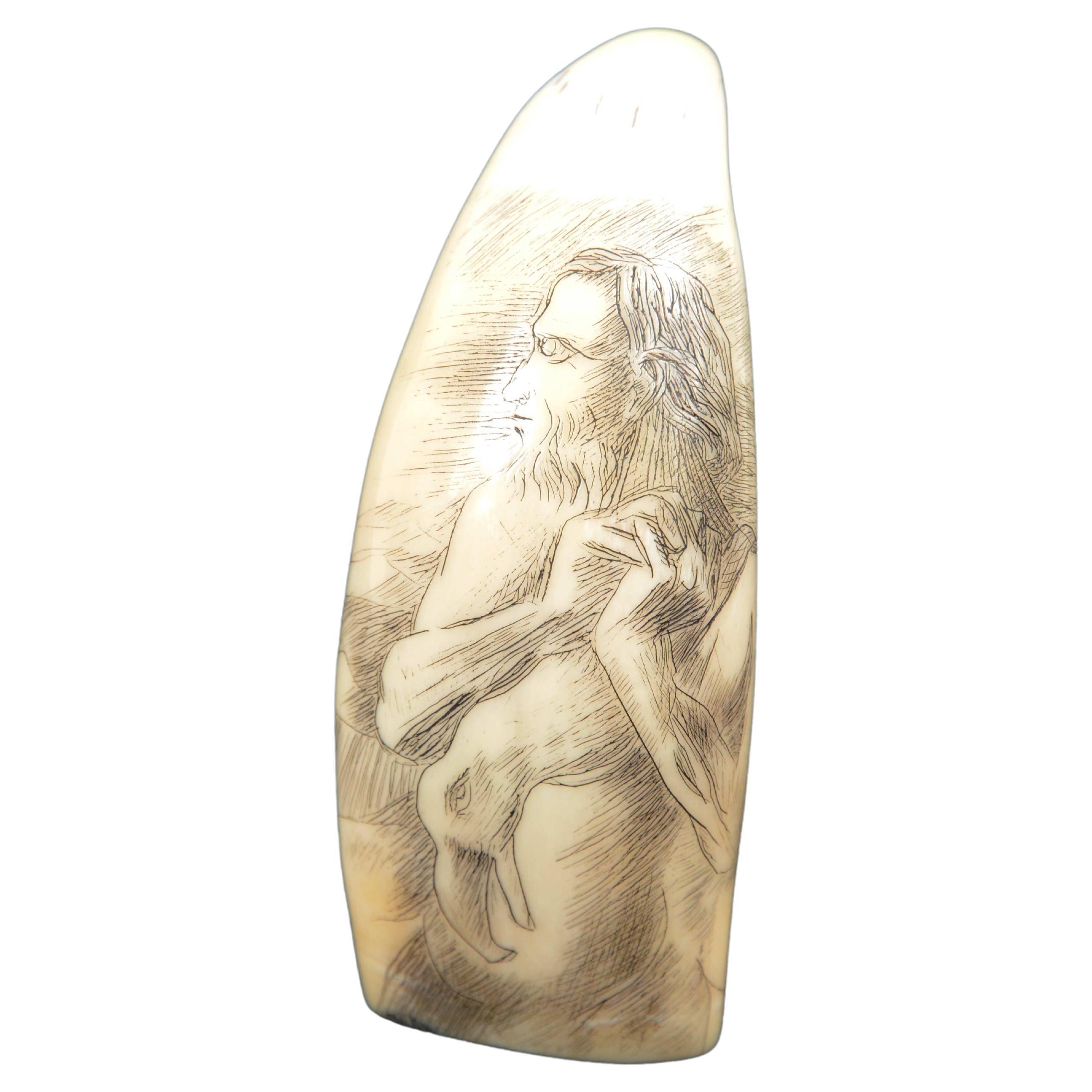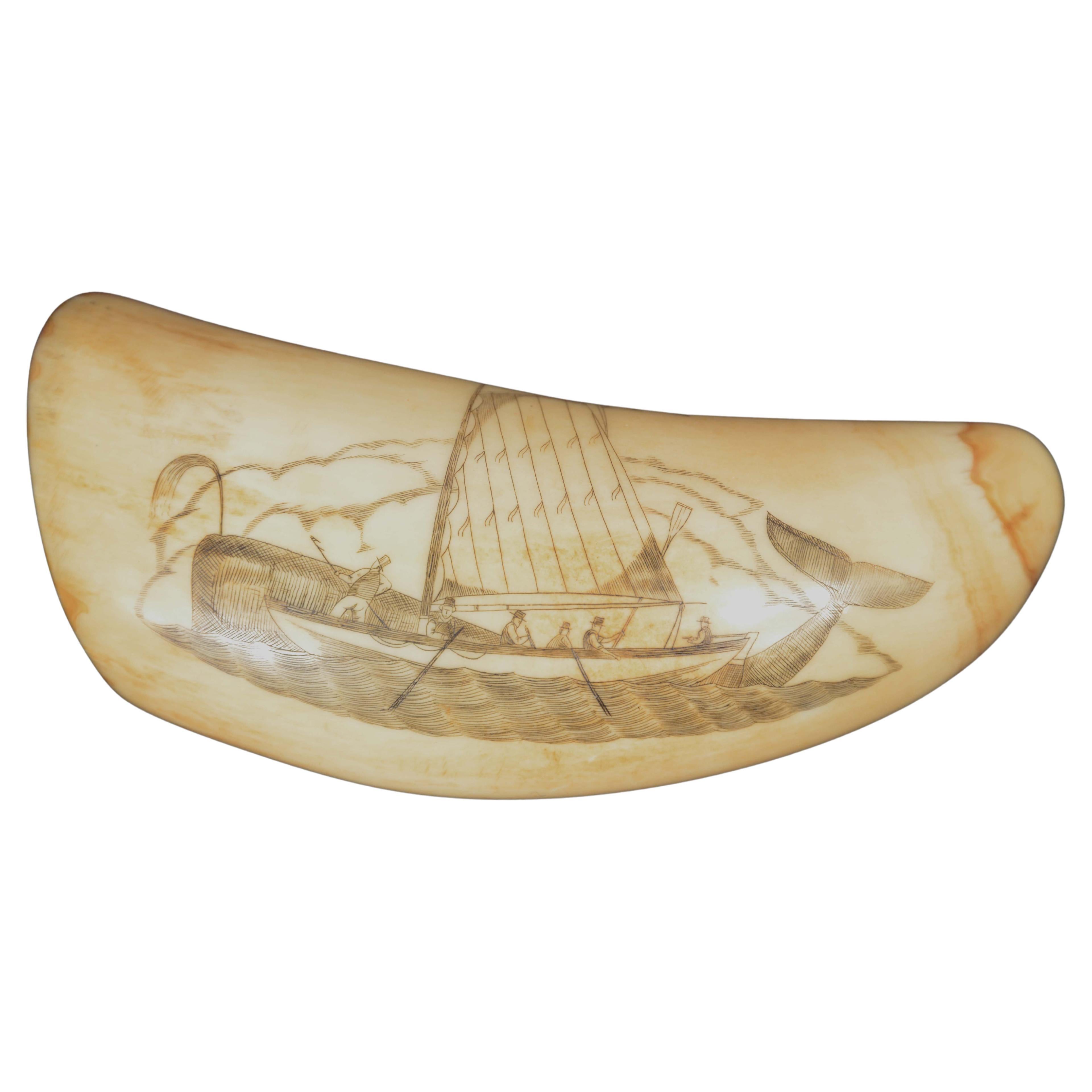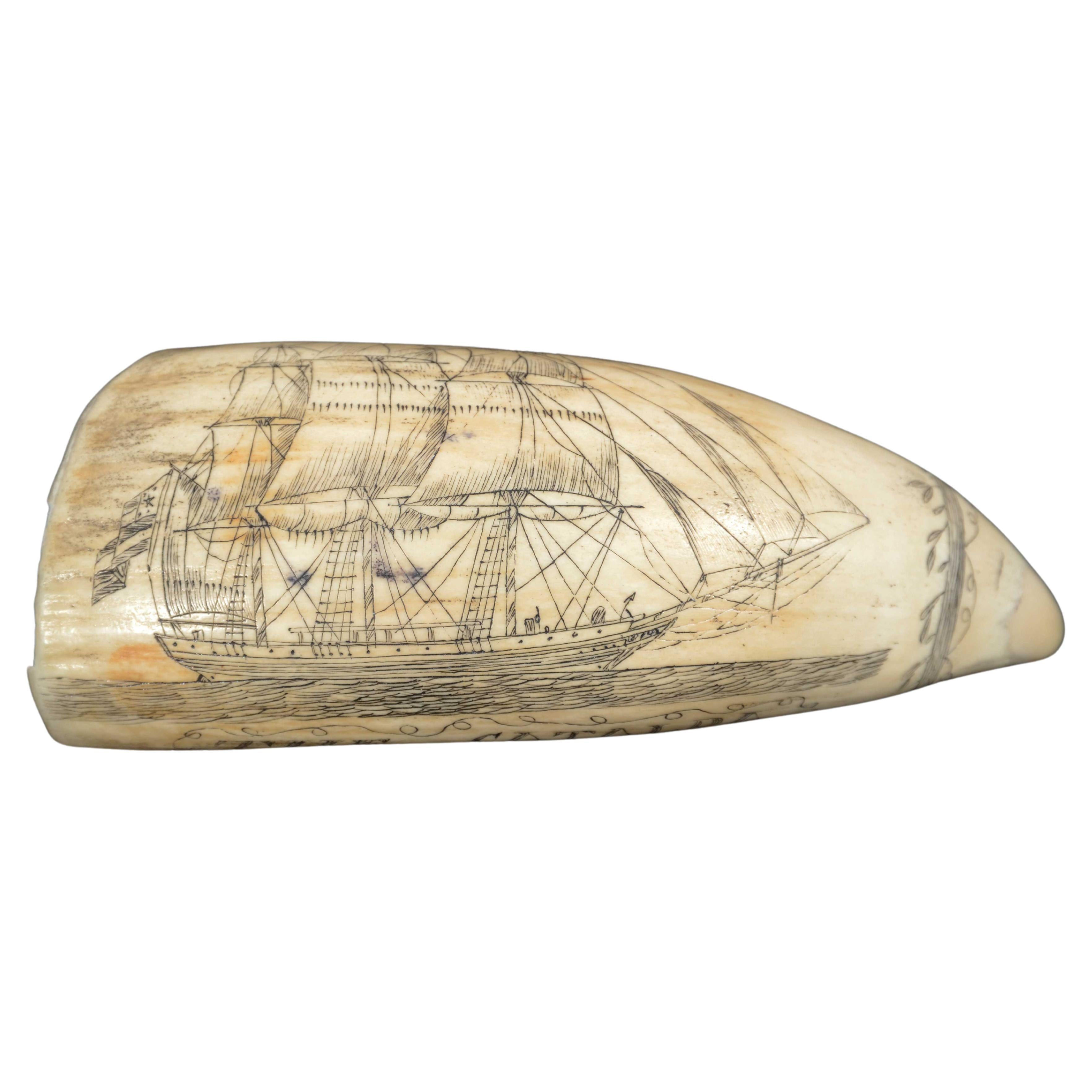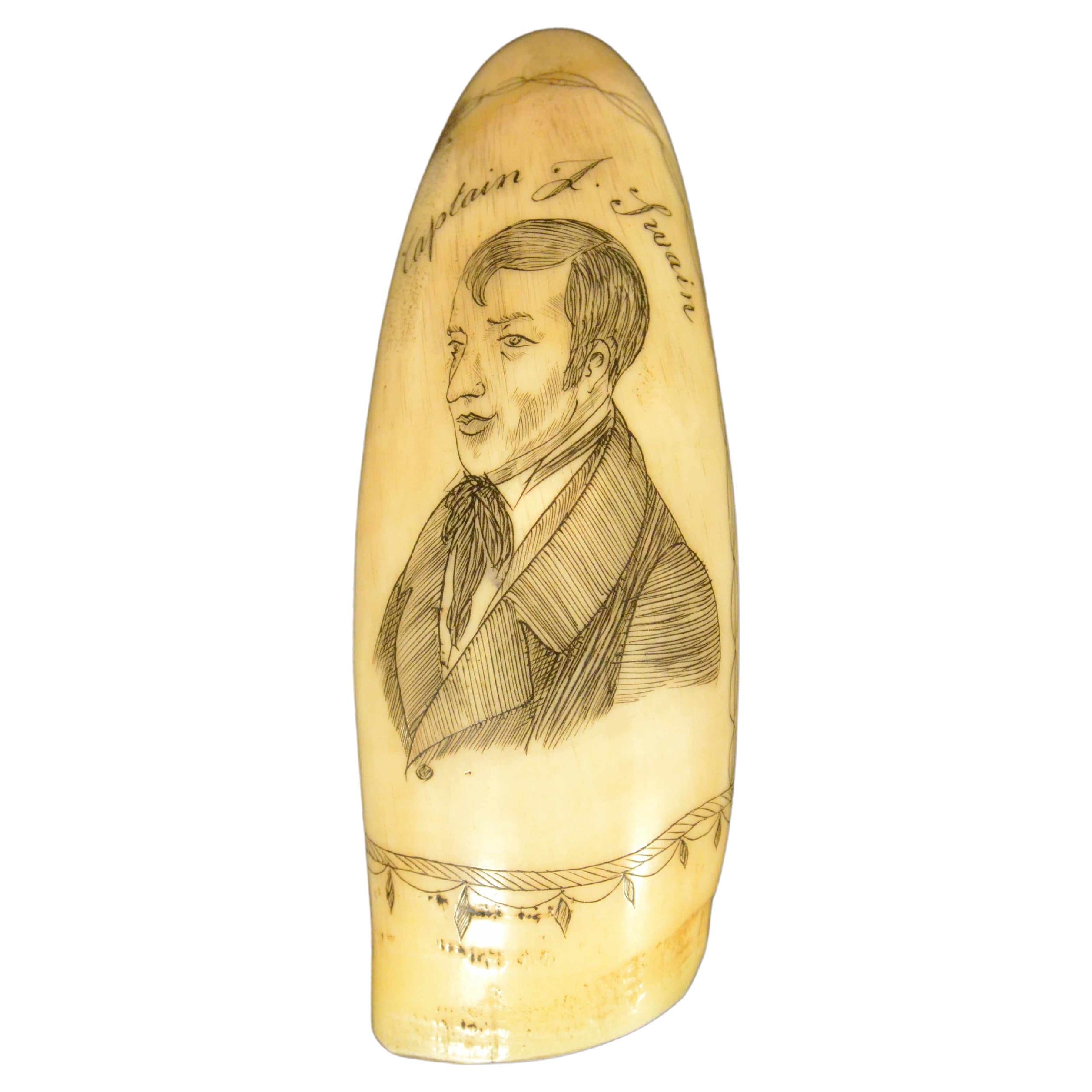Items Similar to Rare scrimshaw of large whale tooth in vertical bas-relief a sailor
Want more images or videos?
Request additional images or videos from the seller
1 of 18
Rare scrimshaw of large whale tooth in vertical bas-relief a sailor
About the Item
Rare scrimshaw of a large whale tooth depicted vertically in bas-relief the profile of a bearded whaler with hat on his head, height 16 cm. Datable to around the mid-19th century. On the back the following engraved inscription: Here's death to the living. Long Life to Killer. Kisses to sailor's wives. And greasy Luck to Whale's.the.
Good state. Measures height 16x 6.5x4.5- inches 6.25x2.65x1.8 height.
The last photo is the gift box.
vThe word "scrimshaw" refers to an art form (and the various products of this art) that developed aboard American whaling ships between 1745 and 1759 as a means of entertainment to occupy time during the long hours aboard; this art form consisted of a process of carving and engraving whale bones and teeth, with which a wide range of both everyday and ornamental objects were made, which were usually made as souvenirs for members of one's family. Nella scelta dei materiali il primo era sicuramente il dente d'avorio del capodoglio. Solo la punta del dente era liscia ed era necessario preparare il resto della superficie ruvida lucidandola. Il dente era ben immerso in acqua salata o calda, spesso con l'aggiunta di potassio. Quindi veniva utilizzata una lima per strofinare e arrotondare la superficie, e infine una carta vetrata fine per completare il processo. L'ultima fase della lucidatura veniva eseguita con pomice o cenere e poi il dente veniva strofinato ancora con il palmo della mano. Each step had to be performed very slowly so as not to affect the smooth surface of the tooth. In terms of subjects for scrimshandering, the most common were a drawing of a ship or scenes of cetacean capture, made with a needle or knife, or an appropriate blade: for example, thanks to Herman Melville we know that some whalers had boxes of dentist's tools specially designed for scrimshandering. The origin of scrimshandering, as the whalers called it, i.e., the art of making scrimshaw, is a mystery: theories range from locating its origin in Eskimo culture or with Native Americans to emphasizing the influence of South Sea islanders. La spiegazione di Edouard A. Stackpole (1903 -1993), giornalista americano, scrittore e storico di caccia alle balene, è forse la più plausibile: lo scrimshaw sarebbe stato semplicemente lo sviluppo marittimo dell'antica arte di intagliare l'avorio, così come era stata praticata per secoli, e in quanto forma d'arte popolare non sarebbe stato altro che un adattamento da parte dei balenieri americani di un antico mestiere.
- Dimensions:Height: 6.25 in (15.88 cm)Diameter: 2.65 in (6.74 cm)
- Materials and Techniques:Teeth
- Period:
- Date of Manufacture:1850
- Condition:Wear consistent with age and use.
- Seller Location:Milan, IT
- Reference Number:1stDibs: LU1020237356952
About the Seller
4.9
Platinum Seller
These expertly vetted sellers are 1stDibs' most experienced sellers and are rated highest by our customers.
Established in 1999
1stDibs seller since 2014
370 sales on 1stDibs
Typical response time: <1 hour
- ShippingRetrieving quote...Ships From: Milan, Italy
- Return PolicyA return for this item may be initiated within 14 days of delivery.
More From This SellerView All
- 7990 Scrimshaw of vertically engraved whale tooth dated around 1850Located in Milan, ITScrimshaw of a vertically engraved whale tooth datable to around the mid-19th century depicting an old sailor with a beard and long hair holding leaning over one shoulder a cormoran...Category
Antique 1850s Nautical Objects
MaterialsTeeth
- Scrimshaw of vertically engraved whale tooth valuable workmanship dated 1882Located in Milan, ITScrimshaw of a vertically engraved whale tooth, of fine workmanship dated 1882, length 12 cm - inches 4.8. The tooth depicts: 6 whalers in rowboat trying to harpoon a whale and whal...Category
Antique 1880s Nautical Objects
MaterialsBone
- Scrimshaw of a vertically engraved whale tooth Ship Huron dated 1839 cm 9Located in Milan, ITScrimshaw of a vertically engraved whale tooth, exquisite workmanship dated 1839, height cm 9, depicting whaler near a rock and partially submerged whale, under the name of the ship...Category
Antique 1830s Nautical Objects
MaterialsTeeth
- Scrimshaw whale tooth engraving of fine workmanship dated around 1850Located in Milan, ITScrimshaw of an engraved whale tooth, of fine workmanship datable to around the mid-19th century, length 10.8 cm, depicting small rowing boat with sail and 6 men on board, one of ...Category
Antique 1850s Nautical Objects
MaterialsTeeth
- Scrimshaw of excellently made engraved whale's tooth dated around 1850Located in Milan, ITScrimshaw of an engraved and beautifully crafted whale tooth dated around the mid-19th century depicting vessel with full sails under sail, on the back a lady in a long dress with in...Category
Antique Mid-19th Century Nautical Objects
MaterialsTeeth
- Scrimshaw of engraved whale tooth depicting the Captain F. Swain 1850Located in Milan, ITScrimshaw of an engraved whale tooth, depicting on one side the half-bust of the smartly dressed and handsome Captain F. Swain. On the Back the inscription Master The WHALER SWAN f...Category
Antique Mid-19th Century Nautical Objects
MaterialsTeeth
You May Also Like
- Rare Scrimshaw Decorated HornLocated in Lymington, HampshireA rare scrimshaw decorated horn, engraved over one side with the Royal Arms countersigned and titled ship profiles for the Great Eastern, the Great Britain,...Category
Antique 1860s English Nautical Objects
MaterialsHorn
- 19th Century Irish Folk Art Whale ToothLocated in Coeur d'Alene, IDIrish Folk Art. This sperm whale tooth was etched during the 19th century, in Ireland. There'sa a drinking sailor on one side, and a barmaid on the other -...Category
Antique Late 19th Century Northern Irish Nautical Objects
MaterialsOther
- Wooden bas-relief depicting the Ascension of Christ, Circle of Cesar BagarBy Cesar BagardLocated in DEVENTER, NLBas-relief depicting the "Ascension of Christ" circle of Cesar Bagard (1620-1707) , Baroque, Walnut, Wood, second half 17th century The relief shows a Christ ascending to heaven s...Category
Antique Late 17th Century French Religious Items
MaterialsWalnut
- Jesus Christ Head Italian Bas-relief Religious Sculpture 1970 circaLocated in Milan, ITA deeply carved Cembran pinewood Christ Head bas-relief, a religious wall hanging panel depicting a Christ head wearing thorns and holding cross. Original ...Category
Late 20th Century Italian Decorative Art
MaterialsPine, Wood
- Antique French Carved and Incurved Oak Bas Relief Plaque of St Luke, circa 1720Located in Dallas, TXA magnificent display of mastery level woodworking, this antique oval plaque of St Luke was not only carved in bas relief, but it has an incurved shape. The concave plaque has severa...Category
Antique 1720s French Louis XV Wall-mounted Sculptures
MaterialsMetal, Steel
- Large Genuine Megalodon Shark Tooth from Indonesia in Display Box (190 grams)Located in New York, NYMegalodon was a prehistoric shark that may have been 50 feet long or more, two or three times as long as the Great White Shark! Just like modern sharks, this prehistoric predator did...Category
21st Century and Contemporary Indonesian Nautical Objects
MaterialsOther
Recently Viewed
View AllMore Ways To Browse
Perer Alexander
Smiths Vintage Collectable Clocks Vintage Collectable Clocks
Maniglia Ottone
Vintage Paddles Oars
Edwin Levick
Fuji Binocular
Navigation Dividers
Royal Navy Telescope
Star Navigation
Vintage Shipwrights Tools
Sail Boat Wood Toy
Collier Bakelite
Nikon Ww11
Siemens Telegraph
Silvani Brighton
Sterling Boating Trophy
Vintage Airguide
Vintage Fishing Net Floats





